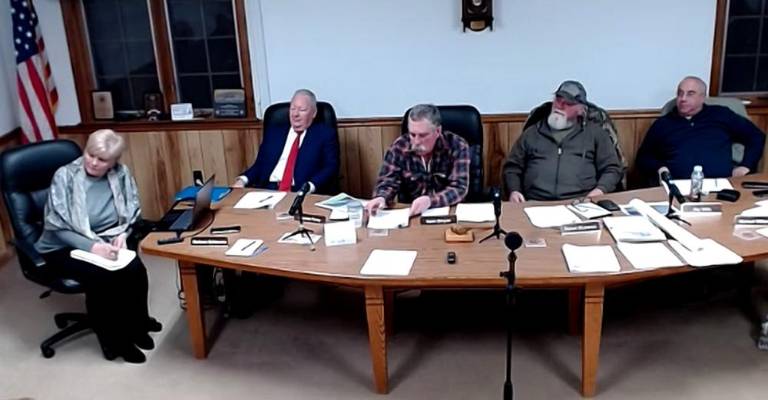Milford discusses revamping zoning, land development rules after warehouse plan ditched
Milford. Members of the Milford Water Authority and the board of supervisors debated what could be done.

At the January 23 Milford Township Planning Commission meeting, the big topic of discussion was how the township, and its neighboring municipalities, could protect the aquifer and potentially avoid applications like the one involving a 435,000-square-foot warehouse at 247 Route 6 in Milford.
That warehouse application was ultimately withdrawn in December 2023 after the prospective buyers of the land, National Land Developers, LLC, terminated its agreement to purchase the property. The move came after a grassroots campaign by area residents urged local lawmakers to stop the application from proceeding, citing the need to protect the aquifer, which runs underneath the property, from the potential contamination that such a warehouse facility could produce.
On Tuesday evening, members of the Milford Water Authority spoke with planning commission members and the board of supervisors about possible changes to the township’s zoning ordinance. The members suggested changes to zoning ordinance 407 titled, “Commercial, Manufacturing and Other Non-Residential Uses.”
Regarding surface and ground water protection, the ordinance states, “All activities involving the possible contamination of surface or ground water shall be provided with adequate safety devices to prevent such contamination. Details of the potential hazards (including the groundwater characteristics of the area in which the use is proposed) and details of planned safety devices and contamination response actions shall be provided by the developer. The Township may require a plan to be submitted for review and approval and may require security for insuring contamination response. Monitoring wells and water quality testing may also be required by the Township. The developer shall also provide details about the use of ground water and any processes that could result in the depletion of ground water supplies. No use shall be permitted which would result in the depletion of ground water supplies. In cases where the use is of such a nature that large volumes of ground water are required, the developer shall provide appropriate hydro-geologic studies which clearly establish that the proposed use will not cause a reduction in the quantity or the quality of ground water supplies available to other properties located within 1,000 feet of any portion of the property where the proposed use will be located.” The ordinance also requires a stormwater management plan and soil erosion control, among other stipulations.
According to the water authority, the warehouse applicants had argued that the ordinance did not apply. The original application included a 6,350-gallon septic tank and an onsite water storage tank of 180,000 to 260,000 gallons that applicant engineers said would not be taken from the aquifer. The applicant’s engineers also estimated that the site would discharge roughly 3,900 gallons of treated sewage per day, which would travel down to the water table about 15 to 20 feet below the sewage disposal area. However, the application did not have a specific tenant attached to it, so the plan, and the various estimates, could have changed once one was established.
Along with a review of ordinance 407, a water authority spokesperson suggested that the township require commercial projects to have zoning and land development applications tracked, filed, and processed together, “so you can’t get land approval without the other.” The thought was that, in doing so, applicants would not be able to drastically change the plans they initially present at the time a conditional use permit is granted.
“If zoning moves along, land development is not even filed yet, and then land development comes in and changes direction,” the spokesperson noted. “We don’t think that’s healthy and suggest they be tracked together.”
However, Planning Commission attorney Tom Farley suggested that process might be too burdensome for the average applicant, adding, “You can’t force them to do that.” He said there was nothing requiring the applicant to work on both applications at the same time.
The water authority spokesperson also noted other areas that could be required, such as training regarding the proper disposal of certain products, and facility inspections. He suggested borrowing ordinances from other municipalities within the state that could also work for the Milford area, as well as those drafted by the environmental group PennFuture.
Another big hurdle was the lack of a water study in the area, and what the potential impact on area wells could actually be.
During the public comment period, one area resident also noted new legislation, H1960, currently in the Pennsylvania General Assembly, that would amend the Pennsylvania Municipalities Planning Code to provide for a local option for “high impact warehouses and distribution centers,” essentially putting such approvals in the hands of voters. The legislation was introduced by State Rep. Joe Emerick on Jan. 18.
Later in the meeting, Planning Commission Chairman Kevin Stroyan asked the water authority whether it would consider taking over the lot in question, thus safeguarding the aquifer from development. The water authority said it had worked toward that option prior to the warehouse application, but once the application came to light, funding sources dried up. The water authority does not want to add the cost of such a purchase to the rate payers, so funding would have to come from other sources, such as federal or state grants, or land trusts. But the water authority was open to reigniting those efforts. If the land could be purchased, it could be turned into a park or other recreational opportunities. The water authority spokesperson also noted that grant applications where multiple municipalities are working together are favored over those without such mutual support, so it would benefit the borough and townships surrounding the property to work together.
While no decisions were made, the group agreed to discuss the matter again during the March 13 workshop meeting at 7 p.m.